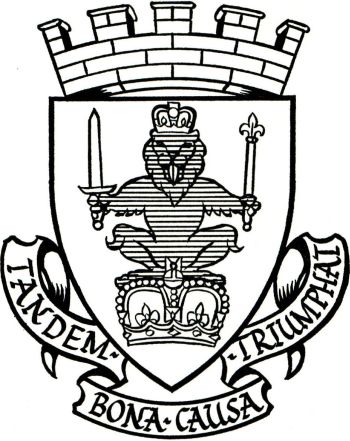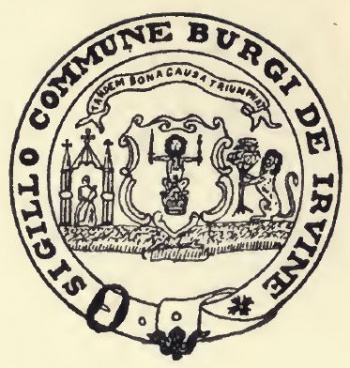Irvine: Difference between revisions
Knorrepoes (talk | contribs) m (Text replacement - "Literature : " to "'''Literature''': ") |
Knorrepoes (talk | contribs) m (Text replacement - " :" to ":") Tags: Mobile edit Mobile web edit |
||
| Line 3: | Line 3: | ||
''' IRVINE ''' | ''' IRVINE ''' | ||
Incorporated into : 1975 [[Cunninghame]] (1996 [[North Ayrshire]]) | Incorporated into: 1975 [[Cunninghame]] (1996 [[North Ayrshire]]) | ||
[[File:Irvine.jpg|center|Arms (crest) of {{PAGENAME}}]] | [[File:Irvine.jpg|center|Arms (crest) of {{PAGENAME}}]] | ||
Latest revision as of 11:33, 11 August 2024
| Heraldry of the World |
| British heraldry portal Civic heraldry of the United Kingdom |
|
IRVINE
Incorporated into: 1975 Cunninghame (1996 North Ayrshire)
Official blazon
Argent, on an imperial crown Or, a lion sejant affrontee Azure, imperially crowned Gold, holding in his dexter paw a sword and in his sinister a sceptre both Proper.
Above the Shield is placed a Burghal coronet and in an Escrol below the Shield this Motto "Tandem Bona Causa Triumphat".
Origin/meaning
The arms were officially granted on May 20, 1927.
Irvine is an early Baronial Burgh dating from between 1214 and 1249, was created a Royal Burgh by King Robert II in 1372.
The arms show the crest of the Kings of Scotland, a crowned lion sitting on a crown and holding the sword and the sceptre. There is an impression dated 1680 of the reverse of one of the oldest known Burgh seals which shows a similar device.
The right to use the Royal crest is said to have been granted to the citizens by King Robert I in return for special services they had rendered to him.
In 1927 Lord Lyon Swinton was unable to grant the arms in the gold and red Royal colours but the choice of silver and blue is a happy one as these were the livery colours of the Bruce family before they assumed the arms of the Lords of Annandale.
The Latin motto - "A good cause triumphs in the end" -is thought to date from and to refer to the Restoration of King Charles II in 1660; it could also be an appropriate reference to King Robert I and his long but successful struggle for Scottish independence.
| Seal of the burgh as used in the 1890s |
Contact and Support
Partners:
Your logo here ?
Contact us
© since 1995, Heraldry of the World, Ralf Hartemink 
Index of the site
Literature: Urquhart, 1974; seal from Porteous, 1906.













